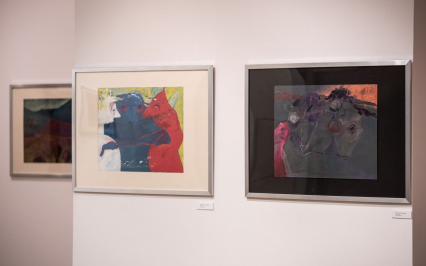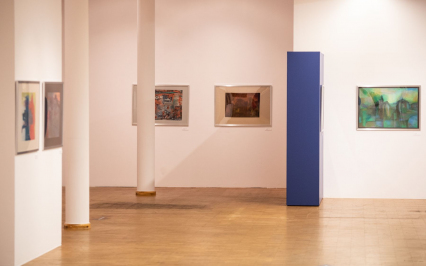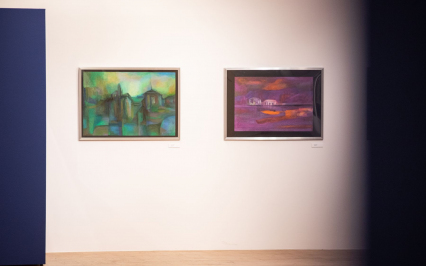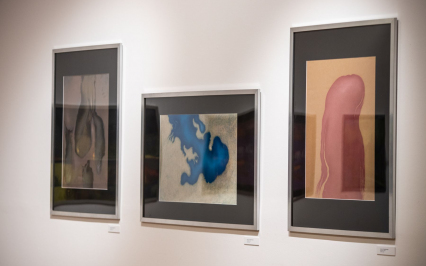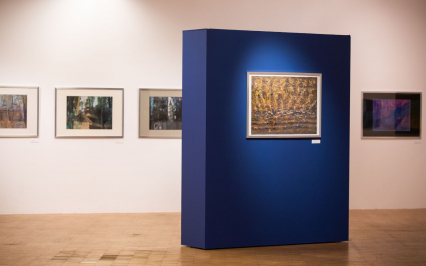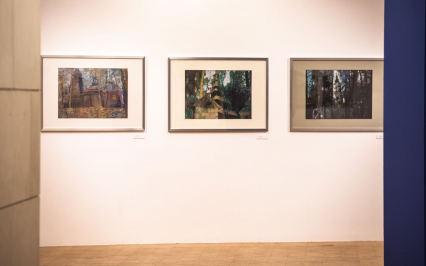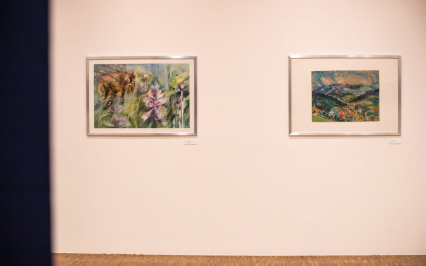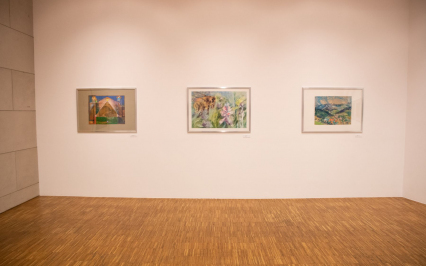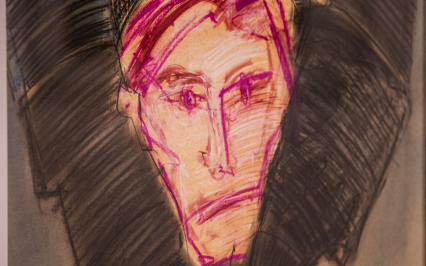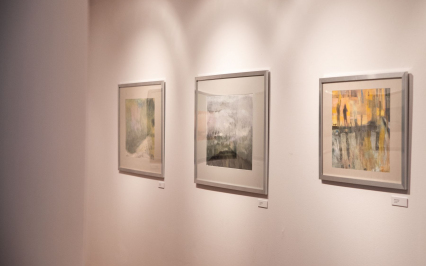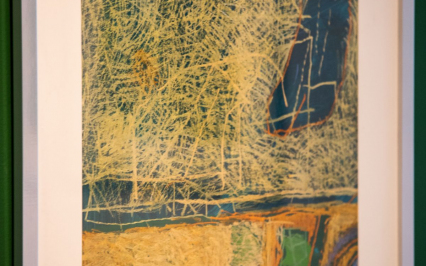Pasta
9 October - 29 November 2020
BWA SOKÓŁ Gallery
Additional information:
Gallery opening hours:
Tuesday - Sunday, 12.00-17.00
Tuesday - Sunday, 12.00-17.00
At the exhibition "PASTA" we present a selection of several dozen works from the collection of the Association of Polish Pastelists. These works are mainly landscape painting made with dry or oil pastel, less often in a mixed technique (as a combination of these two pastel species). By selecting the works for the exhibition, we wanted to show the technical possibilities of pastel, and the variety of representations, a landscape theme common to almost all works - from abstraction to traditional, realistic paintng.
Pastel is a painting and drawing technique, as well as a drawing and painting agent in the from of a coloured stick, used to apply coloured pigments to the surface. Pastel is also referred to as a painting composition made with this technique.
Pastel paints consist of a pigment that gives color, chalk, gypsum and a small amount of binder, most often tragacanth gum. The mixture is formed into thin rollers and then left to dry. Before drying, the pastels have the consistency of a dough, hence the name (Italian for pastello, from paste - cake). Soft pastels - also know as dry, round or square pastels - are most commonly used in the pastel technique, it is the original, most common type of pastel. They have a very soft construction, it is caused by using a very weak rubber solution as a binder. However, oil pastels are also popular - oil is the binder here. They make the pastels transparent, while firmly attaching the pigment to the substrate. Oil paste is available in a smaller range of colours compared to soft paste. In addition, hard pastels, pastel stick (pencils), chalk pastels, wax crayons and recently used water pastels are also used.
The pastel technique is usually described as combining drawing and painting qualities. Rough surfaces are most often used as a subimage for pastel compositions. In the history of this technique, among others, the following were used paper, canvas and even cardboard or parchment. The pastel is rubbed into the approprate paint substrate, but does not penetrate it and stays on the surface. Therefore, a work made in this technique is very susceptible to any mechanical damage, and pastel paints easily flake off most types of painting-support. The delicacy and sensitivity of this technique pose numerous problems, especially in relation to the storage of pastel works in collections. Various types of fixatives are used to fix pastels, but they change the intensity of the colors. The colors are indicated as the main value of this painting technique: they are luminous, soft and gentle (hence the term "pastel colors"). Although the workshop is similar to a drawing technique, the effects achieved with it are essentially painterly. Moreover, pastels, although mechanically sensitive, are resistant to time, and the works made with them retain their color values and intensity for a very long time.
The pastel technique began to be used in European painting at the end of the 15th century, and it developed in the 17th century to gain the peak of popularity in the 18th century, especially among portraitists. The great interest in this painting technique dates back to the end of the 19th and the beginning of the 20th century. The outstanding representatives of this technique in Poland were, among others Stanisław Wyspiański and Stanisław I. Witkiewicz Witkacy. Currently, one of the most interesting artists working in the pastel technique is Stasys Edrigevicius.
Since 1987, the BWA SOKÓŁ Contemporary Art Gallery has been organizing reviews of pastel painting, and since 2002 in the international formula. In 1995, the artists taking part in the exhibitions founded the Association of Polish Pastelists based in Nowy Sącz, which promotes this type of painting.
Artists: Marek Andała, Cyprian Biełaniec, Stanisław Chomiczewski, Jan Chrząszcz, Janusz Cywicki, Alicja Czebotar-Siemaszko, Katarzyna Czuchnowska, Joanna Garasińska, Jerzy Głuszek, Andrzej Guttfeld, Ilona Herc, Maria Idziak, Katarzyna Kania, Andrzej Stanisław Konieczny, Edward Kopaczew, Monika Krzakiewicz-Dańko, Anna Ksykiewicz, Marta Kula, Anna Lenkiewicz, Anna Lewińska, Lidia Maciejewska-Suchanek, Jan Marian Marciniak, Ryszard Miłek, Marek Darek Nierzwicki, Maria Polakowska-Prokopiak, Marta Rak-Podgórska, Małgorzata Ratajczyk, Grzegorz Ratajczyk, Hanna Romańska-Tusiewicz, Marek Rzeźniak, Maria Serwińska-Guttfeld, Marek Sołowiej, Jan Śliwiński, Janusz Trzebiatowski, Elżbieta Zuzelska-Zadora, Katarzyna Zwolińska.
Pastel paints consist of a pigment that gives color, chalk, gypsum and a small amount of binder, most often tragacanth gum. The mixture is formed into thin rollers and then left to dry. Before drying, the pastels have the consistency of a dough, hence the name (Italian for pastello, from paste - cake). Soft pastels - also know as dry, round or square pastels - are most commonly used in the pastel technique, it is the original, most common type of pastel. They have a very soft construction, it is caused by using a very weak rubber solution as a binder. However, oil pastels are also popular - oil is the binder here. They make the pastels transparent, while firmly attaching the pigment to the substrate. Oil paste is available in a smaller range of colours compared to soft paste. In addition, hard pastels, pastel stick (pencils), chalk pastels, wax crayons and recently used water pastels are also used.
The pastel technique is usually described as combining drawing and painting qualities. Rough surfaces are most often used as a subimage for pastel compositions. In the history of this technique, among others, the following were used paper, canvas and even cardboard or parchment. The pastel is rubbed into the approprate paint substrate, but does not penetrate it and stays on the surface. Therefore, a work made in this technique is very susceptible to any mechanical damage, and pastel paints easily flake off most types of painting-support. The delicacy and sensitivity of this technique pose numerous problems, especially in relation to the storage of pastel works in collections. Various types of fixatives are used to fix pastels, but they change the intensity of the colors. The colors are indicated as the main value of this painting technique: they are luminous, soft and gentle (hence the term "pastel colors"). Although the workshop is similar to a drawing technique, the effects achieved with it are essentially painterly. Moreover, pastels, although mechanically sensitive, are resistant to time, and the works made with them retain their color values and intensity for a very long time.
The pastel technique began to be used in European painting at the end of the 15th century, and it developed in the 17th century to gain the peak of popularity in the 18th century, especially among portraitists. The great interest in this painting technique dates back to the end of the 19th and the beginning of the 20th century. The outstanding representatives of this technique in Poland were, among others Stanisław Wyspiański and Stanisław I. Witkiewicz Witkacy. Currently, one of the most interesting artists working in the pastel technique is Stasys Edrigevicius.
Since 1987, the BWA SOKÓŁ Contemporary Art Gallery has been organizing reviews of pastel painting, and since 2002 in the international formula. In 1995, the artists taking part in the exhibitions founded the Association of Polish Pastelists based in Nowy Sącz, which promotes this type of painting.
Artists: Marek Andała, Cyprian Biełaniec, Stanisław Chomiczewski, Jan Chrząszcz, Janusz Cywicki, Alicja Czebotar-Siemaszko, Katarzyna Czuchnowska, Joanna Garasińska, Jerzy Głuszek, Andrzej Guttfeld, Ilona Herc, Maria Idziak, Katarzyna Kania, Andrzej Stanisław Konieczny, Edward Kopaczew, Monika Krzakiewicz-Dańko, Anna Ksykiewicz, Marta Kula, Anna Lenkiewicz, Anna Lewińska, Lidia Maciejewska-Suchanek, Jan Marian Marciniak, Ryszard Miłek, Marek Darek Nierzwicki, Maria Polakowska-Prokopiak, Marta Rak-Podgórska, Małgorzata Ratajczyk, Grzegorz Ratajczyk, Hanna Romańska-Tusiewicz, Marek Rzeźniak, Maria Serwińska-Guttfeld, Marek Sołowiej, Jan Śliwiński, Janusz Trzebiatowski, Elżbieta Zuzelska-Zadora, Katarzyna Zwolińska.




